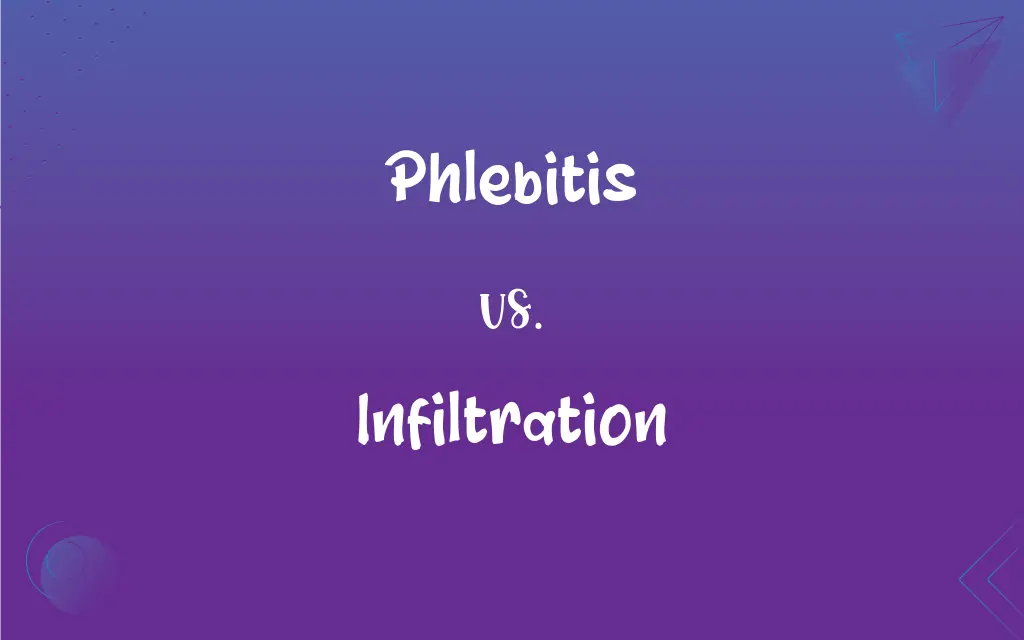Phlebitis vs. Infiltration: What's the Difference?
Edited by Aimie Carlson || By Janet White || Published on March 3, 2024
Phlebitis is inflammation of a vein, often due to irritation from an IV catheter, while infiltration involves the leaking of IV fluid into surrounding tissue.

Key Differences
Phlebitis is a medical condition characterized by inflammation of the veins, typically caused by irritation, injury, or an intravenous (IV) catheter. Infiltration, in a medical context, refers to the inadvertent leakage of IV fluid into the surrounding tissue, often when an IV catheter becomes dislodged.
The primary symptom of phlebitis is pain and swelling along the course of the affected vein, often accompanied by redness and warmth. In contrast, infiltration presents with swelling, discomfort, and coolness of the skin around the IV site, with possible pallor and tightness.
Phlebitis can be caused by various factors, including prolonged IV therapy, certain medications, and trauma to the vein. Infiltration, however, is specifically related to the misplacement or movement of an IV catheter.
The treatment for phlebitis usually involves removing the offending IV line if present, applying heat, and possibly using anti-inflammatory medications. Infiltration treatment typically requires the removal of the IV catheter and applying a warm or cold compress, depending on the infiltrated fluid.
Prevention of phlebitis includes proper IV catheter placement and care, along with regular assessment of the IV site. In contrast, preventing infiltration also involves regular monitoring of the IV site and ensuring secure catheter placement.
ADVERTISEMENT
Comparison Chart
Definition
Inflammation of a vein
Leakage of IV fluid into surrounding tissue
Primary Symptoms
Pain, swelling, redness, warmth along the vein
Swelling, discomfort, coolness, pallor around IV site
Common Causes
IV therapy, medications, vein trauma
Misplacement or movement of IV catheter
Treatment
Removal of IV, heat application, anti-inflammatories
Removal of IV, warm/cold compress
Prevention
Proper IV placement and care, regular site assessment
Regular IV site monitoring, secure catheter placement
ADVERTISEMENT
Phlebitis and Infiltration Definitions
Phlebitis
Phlebitis is the inflammation of a vein, usually in the leg.
After the IV insertion, she developed phlebitis in her forearm.
Infiltration
Treatment for infiltration involves removing the IV and applying a compress.
Cold compresses were applied to reduce swelling from the infiltration.
Phlebitis
Phlebitis can be superficial or deep, affecting the thrombosis risk.
She was diagnosed with superficial phlebitis in her lower leg.
Infiltration
Infiltration is the accidental administration of IV fluid into surrounding tissue.
Infiltration occurred when the IV catheter dislodged from the vein.
Phlebitis
Phlebitis often results from irritation caused by an IV catheter.
The nurse assessed the patient for signs of phlebitis post IV therapy.
Infiltration
Infiltration happens when an IV catheter becomes dislodged.
The nurse reinserted the IV line to correct the infiltration.
Phlebitis
Phlebitis can cause redness, warmth, and swelling along the vein.
He noticed redness and swelling, indicating phlebitis.
Infiltration
Preventing infiltration requires careful IV insertion and monitoring.
Regular checks of the IV site help prevent infiltration.
Phlebitis
Phlebitis treatment includes removing the irritant and applying heat.
Warm compresses were used as part of his phlebitis treatment.
Infiltration
Infiltration can cause swelling and discomfort at the IV site.
The patient's hand swelled up due to infiltration.
Phlebitis
Inflammation of a vein.
Infiltration
The act or process of infiltrating.
Phlebitis
(pathology) Inflammation of a vein, usually in the legs.
Phlebitis
Inflammation of a vein.
Phlebitis
Inflammation of a vein (usually in the legs)
FAQs
How can you identify phlebitis?
Phlebitis is identified by pain, swelling, redness, and warmth along the affected vein.
What are the signs of infiltration?
Signs of infiltration include swelling, discomfort, and coolness at the IV site.
What is phlebitis?
Phlebitis is inflammation of a vein, often associated with IV therapy.
What causes infiltration?
Infiltration is caused by IV fluids leaking into surrounding tissue, typically due to a dislodged catheter.
Can phlebitis be serious?
Phlebitis can be serious if it leads to deep vein thrombosis or infection.
How long does infiltration take to heal?
The healing time for infiltration varies, but it usually resolves within a few days after treatment.
Can infiltration occur in any IV site?
Yes, infiltration can occur at any IV site, though it's more common in the hands and arms.
How is infiltration treated?
Infiltration is treated by removing the IV and applying a warm or cold compress.
Is phlebitis only caused by IVs?
No, phlebitis can also be caused by vein trauma or certain medications.
Are there different types of phlebitis?
Yes, there are superficial and deep phlebitis, with different risks and treatments.
What are the complications of phlebitis?
Complications of phlebitis can include clot formation and infection.
What factors increase the risk of infiltration?
Poor IV placement, movement of the patient, and fragile veins increase the risk of infiltration.
Can infiltration lead to complications?
If untreated, infiltration can lead to tissue damage and infection.
How often should an IV site be checked for infiltration?
An IV site should be checked regularly, typically every few hours, to prevent infiltration.
Can phlebitis be treated at home?
Superficial phlebitis can sometimes be treated at home, but medical advice is essential.
Can phlebitis occur in any vein?
Phlebitis can occur in any vein but is most common in the legs and arms.
How is phlebitis prevented?
Preventing phlebitis involves proper IV placement, care, and regular assessment.
What should you do if you suspect infiltration?
If infiltration is suspected, the IV should be removed, and medical attention should be sought.
Does phlebitis require hospitalization?
Phlebitis may require hospitalization if it's severe or involves deep veins.
Is infiltration more common in certain patients?
Infiltration is more common in patients with small or fragile veins, such as the elderly or infants.
About Author
Written by
Janet WhiteJanet White has been an esteemed writer and blogger for Difference Wiki. Holding a Master's degree in Science and Medical Journalism from the prestigious Boston University, she has consistently demonstrated her expertise and passion for her field. When she's not immersed in her work, Janet relishes her time exercising, delving into a good book, and cherishing moments with friends and family.
Edited by
Aimie CarlsonAimie Carlson, holding a master's degree in English literature, is a fervent English language enthusiast. She lends her writing talents to Difference Wiki, a prominent website that specializes in comparisons, offering readers insightful analyses that both captivate and inform.







































































